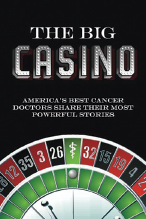
The following essay by Kenneth A. Foon, MD, is adapted from The Big Casino: America’s Best Cancer Doctors Share Their Most Powerful Stories, which was coedited by Stan Winokur, MD, and Vincent Coppola and published in May 2014. The book is available on Amazon.com and thebigcasino.org.
The smartest guys in the room were never from the big energy companies, and they’re not running hedge funds on Wall Street or building the next Facebook. For me, the smartest guys in the room are the selfless men and women who’ve transformed cancer from what was all too often a death sentence to a manageable, and in many cases, curable disease.
And all that progress has happened in my lifetime. During the past 25 years, I’ve seen incredible breakthroughs in cancer research and treatment. I’ve been privileged to work alongside, or in the footsteps of, many of these pioneering researchers. I’ve witnessed discoveries march from the laboratory to the clinic and from there directly to my patients.
The scourge of cancer has a long history. Ancient Egyptians worried about the disease. During the Middle Ages, a time of plagues and rampant infectious disease, it was cancer that was considered the “Emperor of All Maladies.” Cancer was a whispered word when my Uncle Jack was a general practitioner in the 1950s, given the absolute dread it instilled in patients. Among the next generation of medical caregivers, cancer was referred to as “The Big Casino,” which gives you a pretty good idea of the odds against a good outcome.
Today, all this has changed. As I write these words, the odds are continuing to shift dramatically in patients’ favor. Who knows when or how we’ll eventually cure all cancers—cancer is multiform, complex, and endlessly resilient—but the smartest guys in the room are on the side of patients.
Beating the Odds
Let me introduce George Smith (not his real name). When I was at the National Cancer Institute (NCI), we’d occasionally see patients with hairy cell leukemia, a rare, slow-growing, but ultimately lethal blood cancer. The NCI was the last exit in The Big Casino, the place patients might arrive when there was nothing else left to do. George was Everyman, a 40ish, blue collar guy with a family and everything to live for. The odds suggested he’d be dead before he reached 50.
Fortunately, research breakthroughs had given us a trump card, a protocol using the newly synthesized natural immune stimulator, interferon alfa. Interferon alfa was a molecule so rare in the late 1970s, it was rumored that the Shah of Iran, Mohammad Reza Pahlavi, who was battling lymphoma, couldn’t get his hands on it.

Who knows when or how we’ll eventually cure all cancers—cancer is multiform, complex, and endlessly resilient—but the smartest guys in the room are on the side of patients.— Kenneth A. Foon, MD
Tweet this quote
Hairy cell leukemia patients from all over the country, George among them, arrived at the NCI, presenting with grossly enlarged spleens, anemia, infection, and other telltale symptoms of the cancer. We couldn’t cure them, but all of a sudden we could put them into long-term remission and guarantee a good quality of life. Their tumors disappeared, blood counts normalized, enlarged spleens literally shrunk before our eyes. A death sentence became a reprieve, thanks to the smartest guys in the room.
George did well and was able to return to his normal life, and I lost track of him. A few years later, I joined the medical faculty at the University of Michigan in Ann Arbor. One day, I was working in my office when a handyman came in to paint or repair something.
“Hi Dr. Foon!” he exclaimed. “How are you doing?”
I had no idea who he was.
You guessed it. It was George. He’d been asymptomatic for 5 years and was moving on with his life.
The Dawn of Targeted Therapy
When I was a boy growing up in Detroit, my uncle, Jack Weiss, was my role model. Uncle Jack was a general practitioner. His amazing kindness and generosity to his patients inspired me to follow in his footsteps. After medical school and my internship at the University of California, San Diego, School of Medicine—to everyone’s surprise—I accepted a research fellowship at the National Institutes of Health (NIH) to do immunology research. After 3 years of laboratory research, I went to the University of California, Los Angeles (UCLA) School of Medicine to train in hematology and oncology. I guess I was trying to get some clarity about what to do with my professional life.
Over the many years of medical school and internal medicine training, I realized my closest relationships were forged with patients with cancer. Always the toughest and bravest, they were somehow able to face all the fear and anger, the financial stresses, and family issues, with grace and dignity. It struck me that they had clarity. This was the population I most wanted to work with.
On my watch, the leukemias and lymphomas were clearly the most challenging diseases to treat. Thanks to breakthroughs in research, treatment was rapidly evolving away from traditional toxic chemotherapies toward an immunologic approach. One of the new weapons in our arsenal was monoclonal antibodies, and given my medical background, it all made perfect sense.
While I was at UCLA, researchers in Europe were achieving breakthroughs with monoclonal antibodies that would win them the 1984 Nobel Prize in Medicine. My mentor at UCLA was Robert Peter Gale, MD, PhD, a brilliant immunologist and pioneer in bone marrow transplantation who first guided my career toward immunologic approaches to cancer treatment.
A few floors away, immunologists and epidemiologists were studying a cohort of gay men suffering from opportunistic infections and rare cancers that suggested their immune systems had been severely compromised—the first documented study of the HIV/AIDS epidemic. Today, HIV/AIDS is another once rapidly fatal disease that has become a chronic, nonfatal disease because of innovative new antiviral therapies.
From UCLA, I moved to the NCI and worked with Ronald Herberman, MD, whose lab first isolated the immune system’s “natural killer cells,” and Robert Oldham, MD, one of the first pioneers in biologic therapies. Being surrounded by all this incredible intellect pushes you to do more and better. This was the future of cancer therapy, wide open and fruitful. I dove right in.
Making Progress in CLL
One of my areas of specialization is chronic lymphocytic leukemia (CLL), the second most common leukemia in middle-aged adults. Although CLL tends to be an indolent, low-grade disease, patients would die of it faster, for example, than George’s strain of hairy cell leukemia. We’d treat patients and they’d improve dramatically, but we could never hit the jackpot: a complete remission. Decades ago, Dr. Gale and I coauthored a position paper1 that argued there is no such thing as a complete response to treatment for CLL.
Over time, using combinations of chemotherapy and cutting-edge biologic agents like rituximab (Rituxan), we’re edging closer. Other biologic agents act on processes and machinery within the cell or the environment in which the cell lives. They stop cancer cells from dividing and growing. They seek and kill them. They stimulate the immune system to attack them.
We are now seeing the complete disappearance of tumors in more than 50% of our CLL patients. At the University of Pittsburgh Cancer Institute, where I headed the hematology program, I started a trial (using a less-toxic version of a chemotherapy protocol developed at The University of Texas MD Anderson Cancer Center), and I hit a 70% complete response rate.
Walk into any gambling casino with the odds of 70% in your favor, and you’ll break the bank. In fact, I just got a note from my very first patient in that early trial. It has been almost 10 years, and he’s still in remission. How great is that? He had end-stage CLL, has never required any further treatment, and remains in complete remission. He goes to his doctor, gets his blood checked, and he’s out the “Big Casino” door. Just ask him who the smartest guys are in the room. ■
Reference

